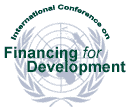
Department of Public Information - News and Media Services Division - New York
18-22 March 2002
19 March 2002
 |
International
Conference on Financing for Development Department of Public Information - News and Media Services Division - New York |
|
| Monterrey, NL, Mexico 18-22 March 2002 |
19 March 2002 |
|
PRESS CONFERENCE BY UNITED STATES
Alan Larson, United States Under-Secretary for Economic, Business and Agricultural Affairs, outlined his country's position regarding development assistance, trade and investment, at a press conference this afternoon.
He highlighted the announcement made last week that the United States would increase its international assistance by $5 billion over the next three budget years. That initiative would achieve, in the third year, an annual level of assistance that was 50 per cent larger than current levels. The President had stressed the need for accountability on the part of both developed and developing nations, as well as the need for good governance and an economic policy framework that promoted entrepreneurship.
On trade and investment issues, Mr. Larson said that the exports of developing countries had doubled over the last decade and were expected to double again in the next decade. Imports to the United States from sub-Saharan Africa had increased by 17 per cent last year. There would also be a high premium on moving ahead with implementation of the Doha agenda.
He said there was now widespread agreement on the crucial role of private investment for promoting development. Mexico, for example, was attracting a lot of investment. A number of other countries, such as Uganda and Honduras, had increased their foreign direct investment (FDI) flows over the last decade. There was an important role for partnerships between the governments of developing countries and private businesses.
Asked how the United States compared to "our brothers in Europe" with regard to international assistance, Mr. Larson replied that the United States was very engaged in the development process in several ways. The first was through its market. The United States was importing $450 billion from developing countries. FDI flows were an important contribution -- even larger than overall official development assistance (ODA) levels -- as were remittances and private philanthropy.
On ODA numbers, he continued, the United States had a positive record. The President had outlined a proposal, which would bring the United States, to a point in three years, where it would be contributing $5 billion more than had been projected.
With regard to his country's position on the use of special drawing rights (SDRs), he said that the SDR approach to development assistance was not a promising path. The idea was to try turning SDRs into a development tool. Some had advocated that idea because it was a shortcut and would involve avoiding parliaments and congresses. He believed it was necessary to go to parliaments and congresses.
A correspondent asked whether the United States had anything to do with the removal of the call for doubling ODA, which had appeared in earlier versions of the consensus. Mr. Larson said that his delegation had worked hard to reach
agreement on a strong commitment. In the past, some countries were talking about a 0.7 per cent ODA target even though assistance levels were moving in the opposite direction. The approach in the consensus represented a credible commitment. The United States believed that when it committed itself to a process, it should take it very seriously.
As to where the extra $5 billion would come from, he said that it would be necessary to go to Congress and the American people and show them that it would be a sound investment and one which would be targeted on achieving the desired development outcomes. Every American had a stake in seeing that development succeeded. It was an opportunity, through investment and trade, to have growth outside the United States contribute to growth inside the United States.
Press Conferences
Conference News